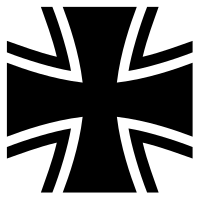Bundeswehr
| Federal Defence Forces of Germany Bundeswehr |
|
|---|---|

Insignia of the Bundeswehr
|
|
| Founded | 12 November 1955 |
| Current form | 3 October 1990 |
| Service branches |
(Joint Support Service) (Joint Medical Service) Kommando Cyber- und Informationsraum (Cyber and Information Space Command) |
| Headquarters | Berlin, Bonn and Potsdam |
| Website | www |
| Leadership | |
| Supreme Command | During normal peacetime: the Minister of Defence After declaration of state of defence: the Federal Chancellor |
| Federal Chancellor | Angela Merkel |
| Minister of Defence | Ursula von der Leyen |
| Inspector General | General Volker Wieker (Heer) |
| Manpower | |
| Military age | 17 |
| Conscription | No |
| Active personnel | 177,608 (20 January 2017) |
| Reserve personnel | 31,700 (2015) |
| Expenditures | |
| Budget | €36.6 billion (FY17) |
| Percent of GDP | 1.22% (FY17) |
| Industry | |
| Domestic suppliers |
Airbus Group Heckler & Koch Rheinmetall Krauss-Maffei Wegmann Howaldtswerke-Deutsche Werft Walther arms ThyssenKrupp |
| Foreign suppliers |
|
| Annual imports | Volume of about $1 billion (2009 est.) |
| Annual exports | Volume of about €6.88 billion (2016) |
The Bundeswehr (German: [ˈbʊndəsˌveːɐ̯], Federal Defence) is the unified armed forces of Germany and their civil administration and procurement authorities. The States of Germany are not allowed to maintain armed forces of their own, since the German Constitution states that matters of defense fall into the sole responsibility of the federal government.
The Bundeswehr is divided into a military part (armed forces or Streitkräfte) and a civil part with the armed forces administration (Wehrverwaltung). The military part of the federal defense force consists of the Heer (Army), Marine (Navy), Luftwaffe (Air Force), Streitkräftebasis (Joint Support Service), Zentraler Sanitätsdienst (Joint Medical Service), and the Kommando Cyber- und Informationsraum (Cyber and Information Space Command) branches.
As of 20 January 2017, the Bundeswehr has a strength of 177,608 active soldiers, placing it among the 30 largest military forces in the world and making it the second largest in the European Union behind France in terms of personnel. In addition the Bundeswehr has approximately 31,700 reserve personnel (2015). With German military expenditures at €36.6 billion, the Bundeswehr is among the top ten best-funded forces in the world, even if in terms of share of German GDP, military expenditures remain average at 1.2% and below the NATO recommendation of 2%.
The name Bundeswehr was first proposed by the former Wehrmacht general and Liberal politician Hasso von Manteuffel. The Iron Cross is its official emblem. It is a symbol that has a long association with the military of Germany. The Schwarzes Kreuz is derived from the black cross insignia of the medieval Teutonic knights; since 1813 the symbol has been used to denote a military decoration for all ranks.
...
Wikipedia
